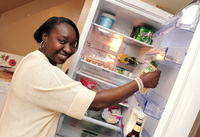The cool way to cut CO2 - Smart fridges trial starts in UK

A domestic fridge freezer that automatically switches on and off to save carbon could be set to make massive cuts in the UK’s CO2 emissions as Europe’s first residential trial of the technology starts.
The new ‘smart fridges’ respond to signals from the national grid and shut down for short periods when energy demand is at its highest, so reducing the output of power stations, without any effect on performance or the freshness of food.
If the trial proves successful, the technology has the potential to make sizeable reductions to the nation’s carbon footprint. Government studies suggest that if every home in the UK was fitted with a smart fridge, CO2 emissions could be cut by two million tonnes each year.
Three hundred smart fridges will be delivered across the UK in the coming months with the first being delivered to residents of Sandwell in the West Midlands. This will be followed by further installations, with up to three thousand fridges set to be included in the trial over the next two years.
The smart fridges rollout is a joint project between npower; social landlord Sandwell Homes; the UK’s leading white goods company, Indesit Company, and smart grid technology developer, RLtec under the Carbon Emissions Reduction Target (CERT), a Government directive which obliges energy companies to help homeowners save energy and carbon.
Key to the smart fridges’ ‘intelligence’ is dynamic demand technology, which works by monitoring second-by-second changes to demand on the national grid and responding during times of peak energy use, such as mornings and evenings, or perhaps when the nation’s kettles are switched on straight after World Cup matches.
During these times the fridge freezer automatically adjusts the power it is drawing reducing the demand on power stations, so helping to cut carbon emissions. The fridges do this automatically without owners needing to take any action and users won’t even notice when they are active or not.
Andrew Howe, CEO of RLtec the company behind dynamic demand technology, said: “A technology in the home that automatically helps to cope with peaks and demands in energy use is an exciting concept and could really help reduce demand on power stations, and see homeowners playing a big role in cutting the UK’s emissions. The smart fridges are simply plugged in as you would with any normal fridge and the technology does the rest – when multiplied across several thousand or several million homes, the carbon saving potential is massive.”
Indesit Company has developed a number of models for the trial to assess the potential for different types of smart fridge. Each model is designed so that temperatures do not rise or fall out of a set range ensuring performance is maintained, regardless of the level of demand on the grid.
Each fridge will be monitored in real time by a data collection system, which will feed information back to researchers to assess the potential CO2 reduction the system could provide in an everyday environment.
Bob Jackson, head of energy efficiency at npower, said: “In our everyday lives we’re all becoming much more tuned into saving energy be that switching off TVs or insulating our lofts. These are great ways of cutting carbon and will continue to be important measures, but smart fridges could be another valuable way of helping to manage energy demand that doesn’t call on direct action. Projects like this are important in understanding the potential such technology has.”
Andriano Mencarini, innovation & digital design director at Indesit Company said: “There are few innovations as simple and effective as ‘smart fridges’ in cutting domestic CO2 emissions. We are on the brink of a major turning point in home energy efficiency. At Indesit, we have a long history of innovation and a strong determination to help the environment and through our joint development with RLtec we are very excited about the future of this technology. We eagerly anticipate the results of Europe’s first trial.”
Julie Brown, a Sandwell resident who took delivery of one of the first smart fridges said: “It’s very exciting to be taking part in this trial and being one of the first people in the world to use a smart fridge. It looks just like a normal fridge freezer and we’ve been using it in just the same way so if it’s helping to cut the UK’s carbon footprint too, that’s great.”
The three partners believe dynamic demand technology could become as common-place as HD TV in the coming years as the UK looks at new ways of reducing its carbon emissions.

